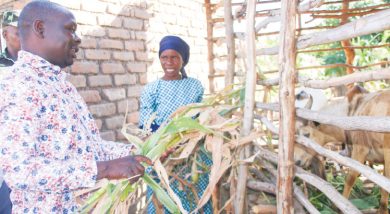Solar-powered irrigation offsets climate shocks
As dry spells and drought become more frequent and devastating, FRANCIS THAWANI, from World Food Programme (WFP), writes how climate-smart technology is helping a smallholder farmer grow, sell and run a shop.
A solar-powered irrigation system is raising crop harvests in Domwe, a rural locality where forests have gone up in smoke in an unsustainable race to supply charcoal to the neighbouring Blantyre City.
“When I was young, the hills surrounding our village was green and had a thick forest,” says Rabson Diwa, a smallholder farmer from the village on the outskirts of the commercial city. “We used to have plenty of rain”.

However, he adds, without other opportunities for poor families to make a living, some members of the community started cutting trees to make charcoal.
“All of this deforestation led to uncontrolled flash waters coming from the hill, washing away our crops and houses.”
Domwe farmers struggled to make a living for years. With fewer trees to cut and less water retained in the ground, they depended solely on the rains to water their crops.
With the climate growing increasingly volatile, food production was plummeting every year. Farmers went back and forth from a nearby river to irrigate small fields of crops with watering cans, but that was not enough to break out of poverty and food insecurity.
“The introduction of solar-powered irrigation is a big relief to Domwe community,” says Diwa.
Solar-powered equipment is part of a climate-smart integrated resilience programme, supported by WFP and the United Kingdom, to improve the livelihoods of people in Domwe community without leaving a large climate footprint.
The irrigation scheme relies on community work that is low-cost, high-impact and multipurpose.
Diwa and fellow community members dig deep trenches that stop the area from flooding when the rainy season arrives, preserving the crops planted and preventing the erosion of fertile topsoil.
Water retained in the trenches recharges the water table, and the solar-powered pumps provide the water for vegetable gardens to flourish.
The gardens, in turn, produce food for the community and livelihoods for the farmers when they sell surplus produce.
“With the project, we have planted trees around the hill and dug deep trenches to control the flow of rainwater and retain water content,” he says.
The irrigation scheme is gradually improving the food security, livelihoods and economic opportunities of the Domwe community.
The gardens provide more predictable yields and a more diverse diet, and the scheme has opened new business opportunities for some smallholder farmers.
Through its Smallholder Agricultural Market Support programme, WFP has linked farmers at the Domwe Irrigation Scheme to stable and competitive markets for their produce.
“We have three hectares of irrigated land where we grow tomatoes, eggplants, carrots and onions,” says Diwa. “In the past few months, three of us have produced 850 kilogrammes of tomatoes, which we sold to a supermarket at K300 000. I used the money from the sales to buy food for my family and to open a shop. The shop is generating extra income that I use to provide for my family.”
Today, Domwe Irrigation Scheme works with over 160 000 families to produce more food and better access to markets for their produce while protecting the environment.
Malawi has been hard-hit by recurring climatic shocks and environmental degradation in the past decade.
An estimated 1.8 million people were declared food insecure due to the effects of last year’s Cyclone Idai and dry spells that affected some parts of the country and the Southern African region.
To address the underlying causes of food insecurity, WFP has taken an integrated approach to resilience to break the cycle of hunger.
Through this approach, WFP is currently supporting some 935 000 farmers in the country, progressively enabling them to tackle climate change while meeting their food and nutrition needs.





